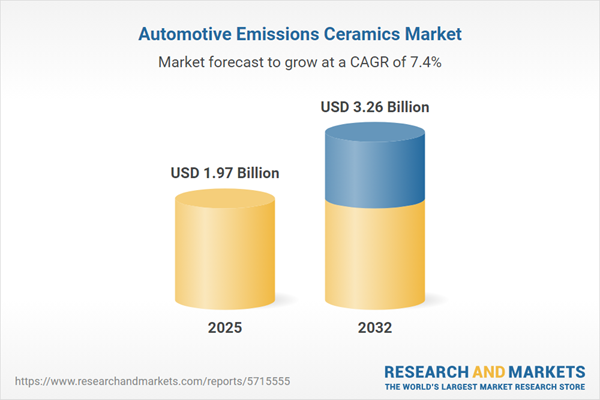Speak directly to the analyst to clarify any post sales queries you may have.
Senior leaders in the automotive sector are facing increased pressure from regulatory shifts and accelerated innovation, making strategic investment in automotive emissions ceramics an essential pathway to compliance, operational resilience, and sustainable growth.
Market Snapshot: Automotive Emissions Ceramics Market
The automotive emissions ceramics market is valued at USD 1.83 billion and is projected to reach USD 1.97 billion by 2025, representing a CAGR of 7.44%. Growth in this market is primarily influenced by heightened global emissions standards, rapid advancements in materials science, and the automotive industry's pivot toward sustainable mobility solutions. Both multinationals and emerging technology players are increasing their commitments to next-generation ceramic components and reinforcing their supply chains. The competitive landscape is defined by widespread adaptation, as established and new market entrants prioritize compliance, modernization, and robust process innovation.
Scope & Segmentation: Automotive Emissions Ceramics Market
This analysis delivers an actionable segmentation designed to address procurement, development, and organizational alignment for senior decision-makers in the automotive emissions ceramics value chain. It outlines primary market dimensions, focusing on supply strategies, technology use cases, and global distribution.
- Product Types: Ceramic substrates, diesel particulate filters, NOx adsorber catalysts, and selective catalytic reduction catalysts serve the emissions control needs of diverse vehicle categories and regulatory jurisdictions.
- Material Options: Cordierite, mixed oxide, and silicon carbide materials are offered in foamed and monolithic forms for thermal resilience and longevity under varying operational demands.
- Application Verticals: Commercial vehicles, diesel buses, heavy-duty trucks, petrol vans, and passenger vehicles each present unique engineering and compliance requirements.
- End Users: Original equipment manufacturers (OEMs), authorized service centers, aftermarket repairs, and digital procurement platforms enable widespread integration of emissions solutions across new and existing fleets.
- Sales Channels: OEM direct partnerships, aftermarket distributors, online procurement systems, and e-commerce support efficient market access and scalability.
- Regional Coverage: Coverage includes the Americas, Europe, Middle East, Africa, and Asia-Pacific, with a focus on evolving regulatory and infrastructure trends in China, India, and Japan influencing competitive dynamics.
- Company Profiles: Features major market participants such as NGK Insulators, Corning Incorporated, CoorsTek, Ibiden, CeramTec AG, Imerys SA, Kyocera Corporation, 3M Company, BASF SE, and Ferro Corporation, exploring their innovation approaches and strategic market positioning.
Key Takeaways for Senior Decision-Makers
- Adopting advanced automotive emissions ceramics early enables organizations to proactively address compliance challenges and support sustainable portfolios as international standards evolve.
- Advances in materials science, notably cordierite and silicon carbide, improve component durability and enhance continuity in both OEM and aftermarket supply activities.
- Diversification of supplier networks and regional sourcing initiatives helps mitigate risk and supports business continuity in periods of regulatory or market turbulence.
- Collaboration among manufacturers, technology firms, and research institutions expedites commercialization cycles, propelling decarbonization and electrification initiatives.
- Digital regulatory management and predictive maintenance technologies streamline compliance procedures and reduce complexities during regulatory changes and maintenance events.
Tariff Impact: Navigating Supply and Cost Pressures
Recent changes in U.S. tariffs have led companies to refine procurement and supply chain strategies within the automotive emissions ceramics sector. Investments in domestic manufacturing and diversified sourcing are pivotal to managing cost and uncertainty. Strengthening partnerships with local suppliers and building regional manufacturing centers are key tactics for maintaining supply and supporting efficient, cost-effective production in the face of shifting global trade policies.
Methodology & Data Sources
This report leverages direct interviews with sector executives, insights from technical consultancies, and comprehensive reviews of current market analyses, regulatory literature, and patent databases. The approach delivers timely and relevant information to inform executive planning in the automotive emissions ceramics field.
Why This Report Matters for the Automotive Emissions Ceramics Market
- Equips leaders with up-to-date market intelligence and segmentation to adapt procurement, foster innovation, and support capital decisions for future growth.
- Provides regulatory frameworks and operational insights for building regionally responsive sourcing and supply chain strategies across global markets.
- Guides differentiation in regulatory-sensitive environments, supporting companies' abilities to sustain competitiveness and operational reliability.
Conclusion
This report enables decision-makers to confidently address regulatory complexity and technological shifts, strengthen automotive supply chains, and secure long-term positioning within the global emissions ceramics market.
Additional Product Information:
- Purchase of this report includes 1 year online access with quarterly updates.
- This report can be updated on request. Please contact our Customer Experience team using the Ask a Question widget on our website.
Table of Contents
3. Executive Summary
4. Market Overview
7. Cumulative Impact of Artificial Intelligence 2025
Companies Mentioned
The companies profiled in this Automotive Emissions Ceramics market report include:- NGK Insulators, Ltd.
- Corning Incorporated
- CoorsTek, Inc.
- Ibiden Co., Ltd.
- CeramTec AG
- Imerys SA
- Kyocera Corporation
- 3M Company
- BASF SE
- Ferro Corporation
Table Information
| Report Attribute | Details |
|---|---|
| No. of Pages | 190 |
| Published | October 2025 |
| Forecast Period | 2025 - 2032 |
| Estimated Market Value ( USD | $ 1.97 Billion |
| Forecasted Market Value ( USD | $ 3.26 Billion |
| Compound Annual Growth Rate | 7.4% |
| Regions Covered | Global |
| No. of Companies Mentioned | 11 |









